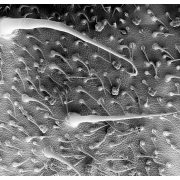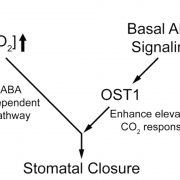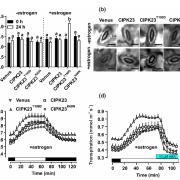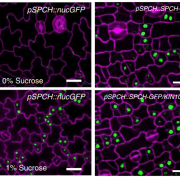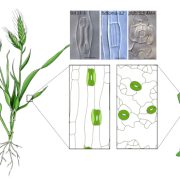Subsidiary cells mediate stomatal closure in maize
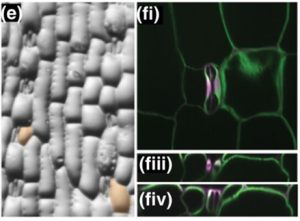 Stomata are pores on leaves which enable gas exchange. In grasses, stomata are surrounded by dumbbell-shaped guard cells that are flanked by subsidiary cells. However, the role of the subsidiary cells in stomatal closure is not fully understood. Here, Liu et al. investigated this using two maize (Zea mays) mutants, called pangloss1 (pan1) and pangloss2 (pan2), which have altered subsidiary cell morphology. The mutations have incomplete penetrance, with 10-30% of stomata having at least one aberrantly shaped subsidiary cell. To test for stomatal closure defects, they moved plants into the dark or rapidly increased the carbon dioxide concentration and measured stomatal conductance. In both cases pan1 plants have normal stomatal closure, whereas it is greatly impaired in pan2 mutants. These experiments measure the entire population of stomata, even those with normal subsidiary cells, therefore, to study individual stomatal complexes confocal microscopy was used. In both pan1 and pan2 mutants, stomatal complexes with at least one aberrant subsidiary cell failed to close upon application of abscisic acid (ABA). Thus, subsidiary cells participate in stomatal closure. (Summary by Rose McNelly @rose_mcn) New Phytol. 10.1111/nph.19379
Stomata are pores on leaves which enable gas exchange. In grasses, stomata are surrounded by dumbbell-shaped guard cells that are flanked by subsidiary cells. However, the role of the subsidiary cells in stomatal closure is not fully understood. Here, Liu et al. investigated this using two maize (Zea mays) mutants, called pangloss1 (pan1) and pangloss2 (pan2), which have altered subsidiary cell morphology. The mutations have incomplete penetrance, with 10-30% of stomata having at least one aberrantly shaped subsidiary cell. To test for stomatal closure defects, they moved plants into the dark or rapidly increased the carbon dioxide concentration and measured stomatal conductance. In both cases pan1 plants have normal stomatal closure, whereas it is greatly impaired in pan2 mutants. These experiments measure the entire population of stomata, even those with normal subsidiary cells, therefore, to study individual stomatal complexes confocal microscopy was used. In both pan1 and pan2 mutants, stomatal complexes with at least one aberrant subsidiary cell failed to close upon application of abscisic acid (ABA). Thus, subsidiary cells participate in stomatal closure. (Summary by Rose McNelly @rose_mcn) New Phytol. 10.1111/nph.19379


